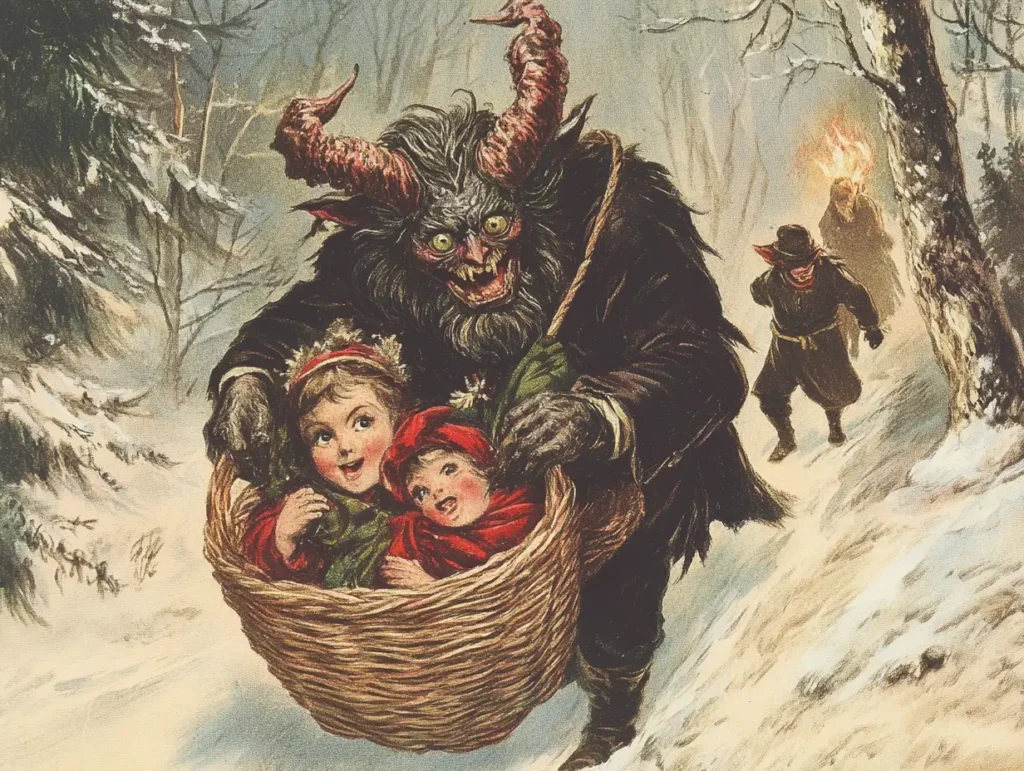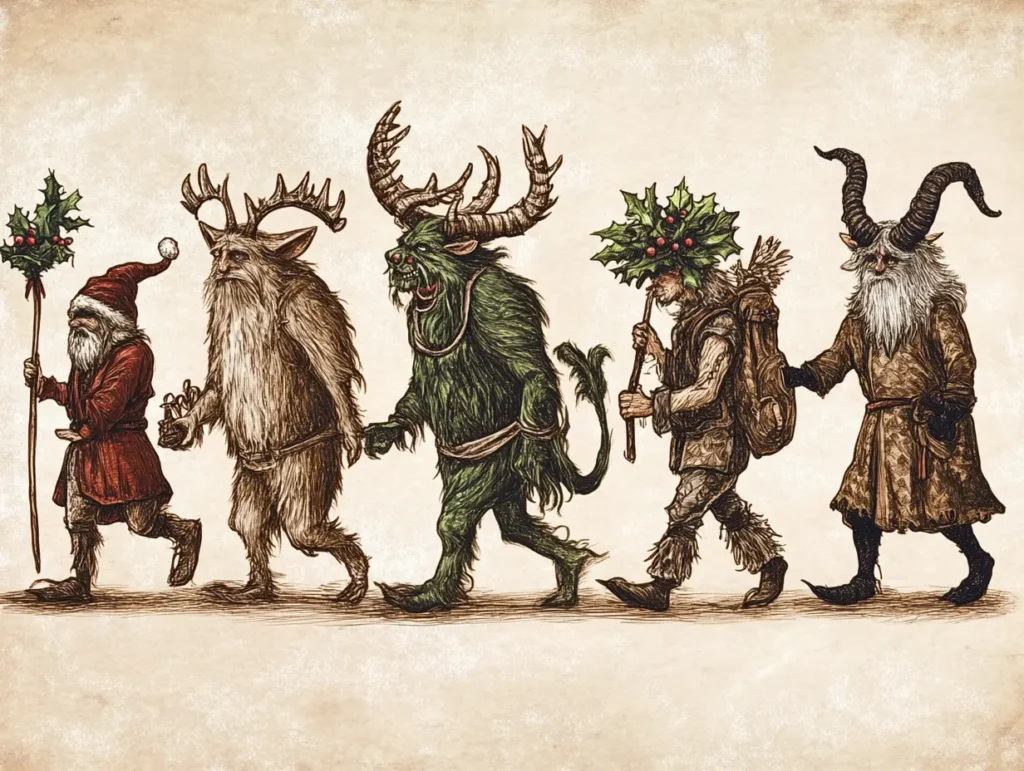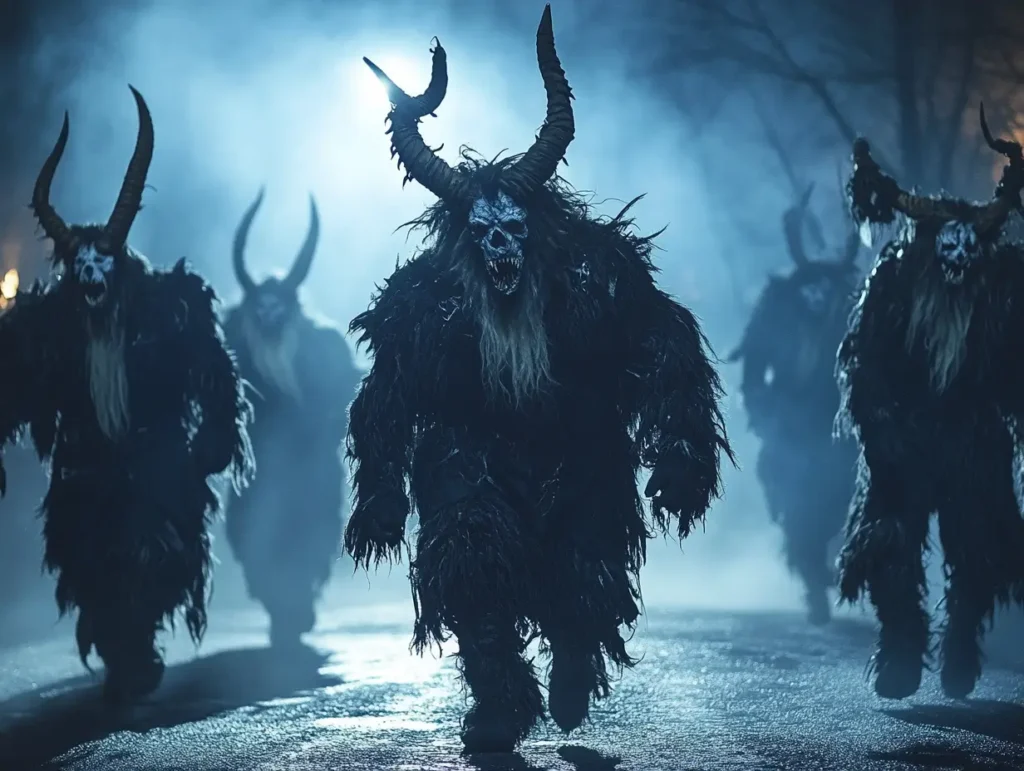Disclaimer: The images in this article are AI-generated via Midjourney and should not be taken as proof and for illustrative purposes only
I first encountered Krampus while flipping through an old book of European Christmas traditions. Unlike most Christmas books or tales, it wasn’t exactly filled with sugar plums and candy canes.
There, staring back at me with gleaming eyes and twisted horns, was Santa’s darker half – Krampus.
We all know about jolly old Saint Nick, with his rosy cheeks and belly that shakes like a bowl full of jelly, but perhaps less is known about his terrifying companion who deals with the children on the naughty list.
Oh yes, Krampus isn’t so much a kind of anti-Santa but rather a companion of Alpine-European origin who works with Santa. Santa gifts the children who are well-behaved, while Krampus and the naughty children, well, we’ll get into that.
This isn’t some modern horror movie creation or marketing gimmick. Krampus has been terrorizing Alpine children for centuries, appearing in folklore long before Coca-Cola gave Santa his red suit.
In fact, the first written mentions of this Christmas demon date back to the 1600s, though the tradition is believed to be much older.
But who or what exactly is Krampus? Why do some parents embrace a tradition that seems more Halloween than Christmas? And how did a horned, tongue-lolling beast become such an integral part of holiday celebrations across Austria, Germany, and beyond?
There’s plenty of holiday mystery to unwrap here, so let’s dive into the world of Christmas’s favorite demon.

The image of Krampus is honestly pretty terrifying. Less “Miracle on 34th Street” and more “Nightmare Before Christmas.” He’s basically what you’d get if you mixed a goat, a demon, Satan, and a particularly grumpy mall Santa – minus the photo opportunities.
This hairy holiday horror stands around 7 feet tall, sports massive horns, has one cloven hoof and one human foot, and carries chains that he’s bound by, leading to ominous rattling and whipping sounds in the night.
Oh, and let’s not forget his abnormally long, devil-like red tongue that would make a particular rock band jealous.
But is he, or it, real?
Well, let’s examine the history books.

So, where did Krampus actually come from?
According to legend, he’s actually the son of Hel (yes, that’s spelled correctly), the Norse god of the underworld.
The name “Krampus” comes from the German word “Krampen,” meaning “claw” – which is pretty on-brand for a creature known for snatching up naughty children. And while today’s parents might threaten their kids with a lump of coal, Krampus takes things to a whole new level.
This guy shows up on December 5th (Krampusnacht or “Krampus Night”) with a bundle of birch sticks for beating, chains for rattling, and a basket for carrying away particularly troublesome children. Some versions of the tale even say he eats them or drags them to hell.
Suddenly, that coal doesn’t sound so bad, does it?
Here’s what’s really interesting: despite the Catholic Church’s best efforts to give him the boot (multiple times, actually), Krampus stuck around.
He became the dark yin to St. Nicholas’s yang, showing up together on December 5th for their annual good cop/bad cop routine. While St. Nick rewards the nice children with presents, Krampus deals with the naughty list in a special way.
Think of it as a medieval scared straight program but with more bells and horns.
Maybe celebrated seems like the wrong word, but there’s no denying that Krampus, or its concept, is still very relevant in today’s world, despite the calls and pushes to try and rid the tradition for good.
In Alpine regions, December 5th (Krampusnacht) remains serious business.
Most notably, it’s a parade held in Austria where people dress up as Krampus and aim to scare and entertain onlookers and passersby. The costumes are typically pretty elaborate, with people sporting demon masks and fur bodies, like big coats or more dedicated designs.
It’s not uncommon to hear the rattles of chains and bells, accompanied by screams and shouts in the streets, and usually some growls, too.
At home, children leave their shoes out, much like stockings in other traditions. Good kids find candy and small toys the following day. Naughty kids? They might find a birch rod – a reminder of Krampus’s potential visit.
You can imagine the kids leaving everything out and hoping they’ve been good enough while hearing these sounds outside the world.
Interestingly, the legend of Krampus hasn’t remained in Austria and has, in many respects, gone global.
Krampus celebrations, similar to the parade above, are celebrated in places in US cities like Cleveland, Washington DC, Los Angeles, and many more.
You’ll find Krampus pub crawls in London, Krampus art shows in Tokyo, and Krampus conventions in Los Angeles. He’s basically become the anti-Santa influencer of the holiday season.
The media has absolutely had a spin on history, as they tend to do.
Perhaps the most famous was the 2015 movie “Krampus,” a typical horror movie that most people don’t really consider scary but funnier, with some serious parts to it. Definitely one to spice up the Christmas movie-watching tradition; although it is rated for 15 years or older, so many wait till the kids are in bed.
There are also plenty of Krampus-related social media trends that tend to pop up every year and go viral.
But here’s what’s really fascinating: while commercialization usually waters down folklore (looking at you, friendly modern vampires), Krampus has somehow maintained his edge.
Maybe it’s because we’re all secretly tired of saccharine holiday cheer, or perhaps there’s something deeper at work here.
After all, when was the last time a centuries-old tradition got more authentic rather than less? 🤔

With all this in mind, a few questions arise.
Firstly, is Krampus real?
Well, despite the legends, there are no reports of Krampus being real or people having experienced Krampus. Unlike legends like Bigfoot, who have received thousands of reported sightings over the centuries, Krampus has a mere zero.
Maybe those experiencing it just didn’t live to tell the tale? 😉
But then why, if there are no tales or reports, do we still love the idea of Krampus?
When you really think about it, in an age where we debate whether telling kids about Santa is lying, how does a chain-wielding holiday demon not only survive but thrive? It’s quite a cultural puzzle, and I think there are some fascinating pieces to examine.
Remember when your parents said “Santa’s watching” to get you to behave?
Well, Krampus takes that idea and cranks it up to eleven.
But here’s the interesting part – child psychologists have actually studied the impact of Krampus-like figures in folklore. Some argue these scary stories serve as a healthy way for children to process fears and understand consequences, kind of like how fairy tales work.
Dr. Maria Tatar, a professor of folklore at Harvard, points out that children often embrace scary stories as a way to master their fears. Think about it – isn’t there something empowering about facing the scariest Christmas creature and surviving to tell the tale?
But Krampus isn’t just about scaring kids straight. In many ways, he represents something our sanitized modern celebrations often lack – balance. Just as nature has summer and winter, day and night, the holiday season traditionally had both light and dark aspects.
Consider these worldwide parallels:
It seems every culture has its own version of this good cop/bad cop routine. It’s like Yin and Yang. If you have something that’s so amazingly good and beautiful, you need to have a dark side, a bad side, or even an evil side, to balance it out.
It’s the natural order of the universe, after all, and even celebrations need it.
And maybe that’s more important these days than ever.
In our age of carefully curated social media positivity and pressure for picture-perfect holidays, perhaps Krampus offers something refreshingly honest.
He’s ugly, scary, and makes no apologies for it. There’s something almost therapeutic about that, especially during the forced cheer of the holiday season.
Plus, let’s be honest – in a world where “Baby Shark” gets remixed into Christmas songs, maybe we need a little Krampus to balance things out.
But is Krampus just filling our need for holiday counter-programming, or is there something deeper at work? Well, that brings us to our final thoughts…
So now I ask of you, where do you sit when it comes to Krampus?
Generally speaking, there is no definitive answer.
Is he an ancient pagan god who survived Christianization? A medieval invention to keep kids in line? Or just a really effective way to make department store Santas seem more appealing?
The truth is, like many great folklore figures, Krampus is whatever we need him to be.
He’s survived centuries of attempts to ban him, outlast him, and even commercialize him, yet he keeps coming back stronger than ever. That’s pretty impressive for a guy who looks like he raided a Halloween store and a Christmas shop at the same time.
What makes Krampus truly fascinating isn’t just his longevity – it’s his adaptability. In an age where we’re constantly debating how to talk to kids about consequences, how to balance tradition with modern sensibilities, and whether our holidays have become too commercialized, here comes this ancient figure offering his own unique perspective on all of these issues.
Think about it: while Santa has been gradually transformed into a friendly corporate mascot who brings everyone presents regardless of behavior, Krampus has steadfastly remained… well, Krampus.
There’s something almost refreshing about his refusal to be watered down.
For those intrigued by this holiday anti-hero, the good news is that Krampus celebrations are more accessible than ever.
Whether you’re interested in attending a Krampuslauf, starting a Krampusnacht tradition, or just adding some edge to your holiday decorations, there are plenty of ways to incorporate this ancient tradition into modern celebrations.
Just remember to pack your running shoes if you’re heading to any Krampus events. Those guys in the costumes take their roles pretty seriously! 😈🎄
Well, that’s all from us here at Donut Earth this time. Wishing you Merry Christmas, and hopefully you’ve behaved yourself enough so you won’t get dragged off to hell this year. Maybe you can get on its good side by leaving out some schnapps for Krampus alongside Santa’s cookies and milk.
After all, even Christmas demons probably need a little holiday cheer occasionally.
No filler. Just the good stuff, glazed with care.
No filler. Just the good stuff, glazed with care.